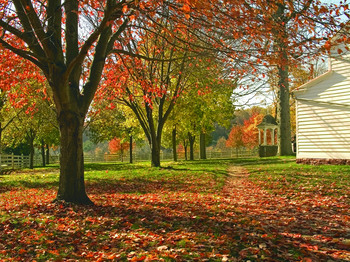8 Expert Tips For Autumn Lawn Care
Posted on September 1, 2018

The sun rises later and sets earlier. The nights are cooling off, followed slowly by the days. Autumn is upon us! Many people stop thinking about their lawns aside from raking leaves at this point in the year. Unfortunately, if you ignore your lawn once the cooler weather hits, you may just be creating more work for yourself in the spring and summertime. There are a few steps that you can take as a homeowner every autumn to improve and maintain the appearance of your lawn once spring hits and your lawn dethaws.
Find Out What Sort of Grass You Have
The most important part of taking care of your lawn is being knowledgeable of what sort of grass you have. There are certain types of grass that grow better in the warm weather, and types that grow better in the cooler weather. Some examples of cool-weather grass types are rye, fescue, Kentucky blue grass and bent grass. Examples of the opposing type, warm weather grass, would be Bermuda grass, Saint Augustine grass, zoysia grass, and buffalo grass. Knowing what kind of grass you have is an important factor in knowing when to fertilize your lawn, which will be discussed in more detail shortly.
Keep Mowing Your Grass
Contrary to popular belief, you actually want to keep mowing your lawn so long as the grass continues to grow. The longer the grass grows, the less sunlight the crown of the grass plant actually receives. For your final two mowings of the season, drop your mower's setting to its lowest setting to give the crown of the grass a burst of energy and make cleaning up leaves less of a chore.
Fertilize Your Lawn in the Autumn
There is a very strong chance that most if not all of Norbys customers grow cool-weather grass in their yards. It might seem strange, but fertilizing this grass is most effective during the cooler months of the late year. The reason why this is a good idea is that despite the leaves of the grass plant growing more slowly, the roots and the “rhizomes” continue to grow quickly. The rhizomes are the horizontal plant stems that grow just beneath the soil's surface and produce the blades of grass above ground. Wait until mid-to-late autumn, and then apply dry lawn fertilizer to your entire lawn. By spring and summer, you should have lush, bright green grass.
De-Weed Your Lawn
Autumn is the prime time to work on killing the perennial weeds in your lawn. They absorb herbicides most readily at this time of year. The absorption of herbicides is done best on days with moderate temperatures and moist soil.
Repair Your Lawn
If you have any “bald spots” on your lawn, autumn is a good time to lay down more seed, especially if you're fertilizing. Stop by your local Norbys and let us help you figure out the best lawn mixture for your lawn.
Rake Your Yard
Nobody really needs to be told that they need to rake their lawn. However, it's important to note that you will maintain a healthier lawn if you rake at least once a week once the leaves begin to turn colors and fall from the trees. As the colors peak and the leaves fall at heavier rates, you may wish to rake everyday or every other day. The less time your grass spends smothered and covered up by dead leaves, the healthier it will look and be.
Aerate the Soil
To prevent thatch from forming and to give the grass's roots effective breathing room, it's important to aerate your lawn if you've had a particularly damp or dry summer. Thatch will suffocate your grass and may cause dead patches throughout your yard. Aerating is done using an aerator, a piece of equipment that can be bought or rented from hardware stores.
Replace Your Mower's Fuel
Remember when you are finished with your final mow of the autumn season to drain any old fuel from your lawn mower or aerator. It isn't good for your equipment to have the fuel sitting in its tank all winter long, nor is it good for the motor to use months-old fuel in the spring!
Blog Archives
- January 2020
- December 2019
- November 2019
- October 2019
- September 2019
- August 2019
- July 2019
- June 2019
- May 2019
- April 2019
- March 2019
- January 2019
- December 2018
- September 2018
- July 2018
- May 2018
- April 2018
- January 2018
- December 2017
- November 2017
- October 2017
- August 2017
- June 2017
- March 2017
- February 2017
- January 2017
- December 2016
- November 2016
- September 2016
- August 2016
- July 2016
- January 2016
- November 2015
- October 2015
- January 2015
- October 2014
- September 2014
- August 2014